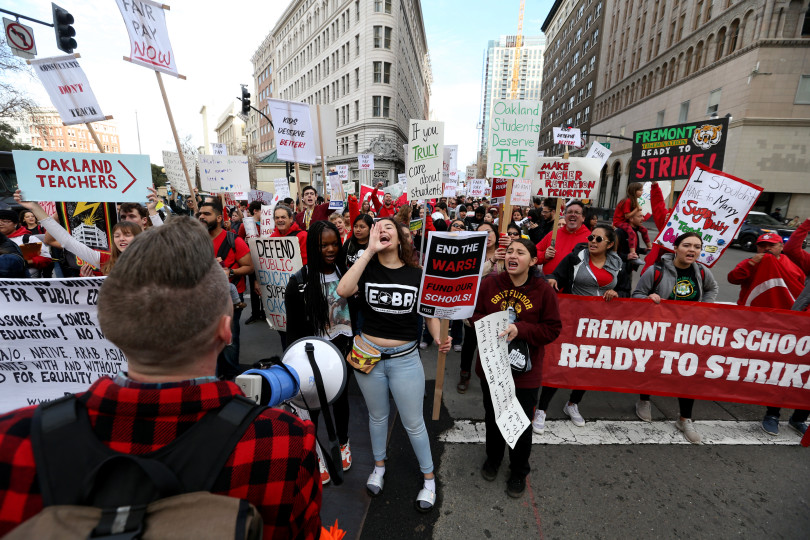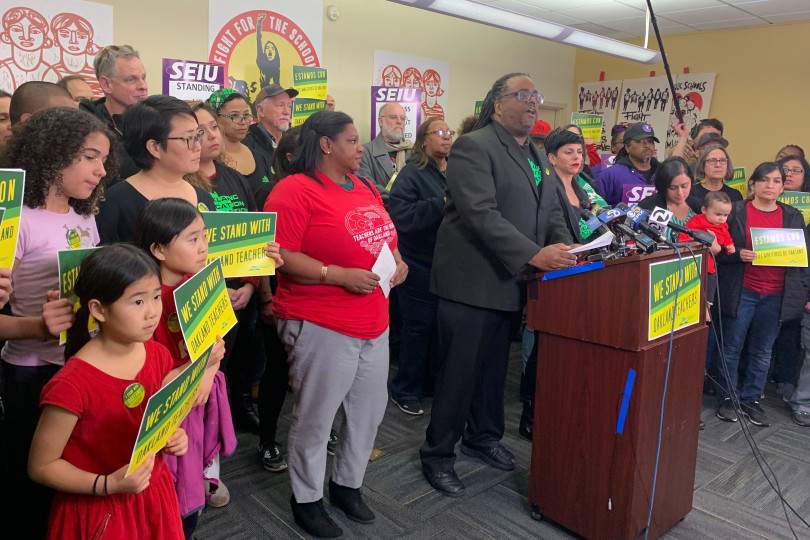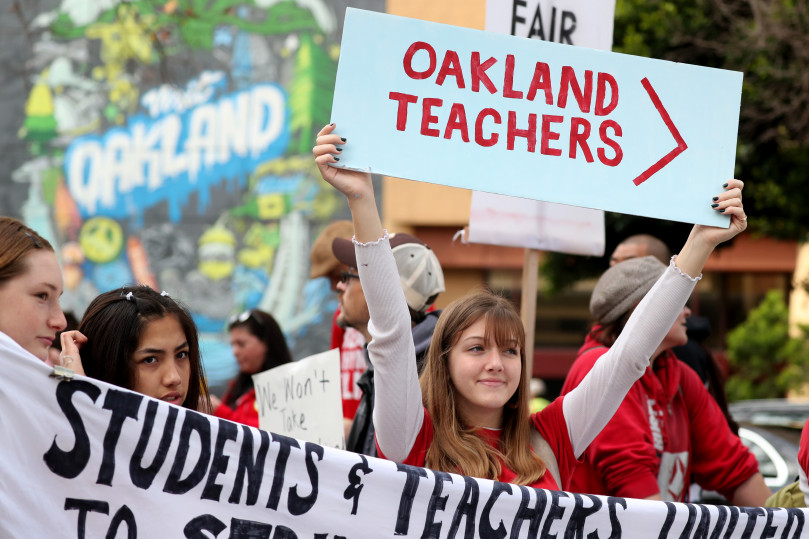
Teachers, students, and parents walk the picket line outside of La Escuelita Elementary School in Oakland, California, on March 1, 2019. Ray Chavez/MediaNews Group-The Mercury News via Getty Images
Oakland teachers are returning to their classrooms today after seven days on strike. And they’re bringing $38 million in pay raises with them.
On Sunday, the local teachers union and school officials in Oakland cut a deal after more than a year of contract negotiations. While the city’s 2,000-plus teachers didn’t get everything they demanded during the strike, they got a lot more than the district wanted to give them. Most notably, teachers snagged an 11 percent pay raise over four years and a 3 percent bonus — nearly double the pay raise district officials had offered before teachers walked off the job.
The school district agreed to hire more school counselors, psychologists, and special education teachers to shrink the large workloads those staff members have taken on. The district also agreed to give school nurses generous bonuses and raises, as part of an effort to keep and attract school nurses in an area with a high cost of living.
Teachers were less thrilled by other parts of the deal, though — namely, the modest decrease in class sizes, which will only shrink by one or two students in the next two years, depending on whether or not the classes are in high-need schools. The district also refused to cancel its plans to close about two dozen schools to pave the way for new charter schools or combine low-enrollment schools. School officials did say they would hold off on some closures and that they would push for a statewide moratorium on charter school expansion.
“The real victory of our historic strike for the schools our students deserve lies in the power and unity we built at our school sites, in our union, and in the city of Oakland,” said Keith Brown, president of the Oakland Education Association labor union, during a press conference Friday. “Tens of thousands of Oaklanders of all ages joined us on our picket lines and at our mass rallies and actions.”
Oakland teachers had stopped going to work on February 21, kicking off the nation’s fourth major teacher strike of the year. Their union has been negotiating a new contract with school officials for more than 18 months, and wanted the district to pay teachers a lot more money — enough to live in one of the most expensive areas of the country.
The walkout came less than two months after teachers in Los Angeles launched their own strike with similar demands in January. Teachers in Denver and West Virginia recently went walked off the job too. And just like in those strikes, teachers in Oakland drew support from parents and students, which helped teachers pressure school officials to give in to many of their demands.
The Oakland school district needs to come up with a lot of money
Oakland teachers share a lot of the same frustrations that led LA teachers to walk out of class in January. They say school districts are spending too much money on privately run charter schools that have little public oversight. They also believe they are paid too little to work in a state that has so much wealth.
California is among the states that spend the least on each student (adjusted for the cost of living), largely because of the state’s strict limits on property tax rates.
The Oakland Education Association has been trying to negotiate a new contract since the last one expired in 2017. Teachers wanted a 12 percent pay raise over three years, smaller classes, and more support staff. The district had offered a 5 percent raise over three years. Teachers rejected the offer. The also rejected a 7 percent raise school officials later proposed.
“We have had it. Enough is enough; bargaining with our school district has not worked,” Brown, who is also a middle school teacher, said during a press conference the weekend before the strike. “Our schools have been starved of resources for years.”
Teachers say the lack of investment in city schools is hurting student performance. The cost of living in Oakland has also skyrocketed in recent years, due to an influx of high-skilled workers unable to afford housing across the bay in San Francisco.
The average one-bedroom apartment in Oakland costs about $2,680 per month, but new Oakland teachers earn about $46,500 a year. That’s the main the reason Oakland has struggled to keep qualified teachers, Brown said, pointing out that 571 Oakland teachers left the classroom last year.
The school district pushed back against teachers’ demands with a simple argument: The city doesn’t have the money.
That’s true.
Oakland schools are facing a $56 million budget deficit in the next two years, so the school board wants to cut school spending, not increase it. Superintendent Kyla Johnson-Trammell is urging state lawmakers to invest more money in public schools, but she now needs to come up with more than $35 million dollars to pay for raises and new hires.
That’s why the district still plans to close schools that were shrinking because of low enrollment. The superintendent acknowledged Sunday the financial solution is not ideal but will help cover pay raises until the district finds new sources of funding.
“Words cannot express how deeply grateful I am that this strike has come to a close,” Johnson-Trammell said in a statement on Sunday, after the union and district ratified the new contract. “We know that not all members were fully supportive of the contract terms. I understand the sense of urgency to fix all of our long-standing fiscal and systems issues, but the reality is that it will take a few years to stabilize the District.”
In the meantime, the Oakland strike gives new energy to a national trend playing out in red and blue states across the country. More than 100,000 public school teachers in six states have walked out of class in the past year, rebelling from years of stagnant wages, crumbling infrastructure, and deep budget cuts to education.
The strikes in Arizona, West Virginia, Kentucky, Oklahoma, California, and Colorado had broad public support, forcing state lawmakers to raise pay and fueling a national movement to boost investment in public education.
So far this year, the momentum has only continued to build. And it points to broader frustration playing out across the U.S. labor force.
Teachers are leading a national workers’ revolt
A record number of U.S. workers went on strike or stopped working in 2018 because of labor disputes with employers, according to new data released last week by the U.S. Bureau of Labor Statistics. A total of 485,000 employees were involved in major work stoppages last year — the highest number since 1986, when flight attendants, garbage collectors, and steelworkers walked off the job.
Frustrated public school teachers were behind the year’s largest walkouts, but hotel housekeepers and steelworkers also organized strikes that lasted for days.
There are no signs that worker angst has subsided. So far, in 2019, teachers in three major cities have gone on strike, including Oakland, and nearly all of West Virginia’s teachers did too. The Los Angeles teachers strike shut down the nation’s second-largest school district for more than a week in January.
As part of their deal with city officials, teachers agreed to a 6% raise and slightly fewer students in each classroom, according to Alex Caputo-Pearl, the president of United Teachers Los Angeles, a labor union that represents about 34,000 public school teachers, nurses, librarians, and support staff in the city.
In mid-February, more than 2,000 teachers in Denver went on strike for three days. The school district ended up giving educators an extra $23 million in pay and agreed to overhaul the compensation system, which relied heavily on annual bonuses.
A week later, about 19,000 teachers walked off the job in West Virginia, closing down nearly every school in the state for the second timein a year. But this time around, teachers were not fighting for pay raises. They’re protesting Republican efforts to privatize public education.
By the end of their first day on strike, West Virginia lawmakers had agreed to put those plans on hold.
Now Oakland’s teachers have also racked up some major wins after walking off the job, and Sacramento teachers may follow.
















